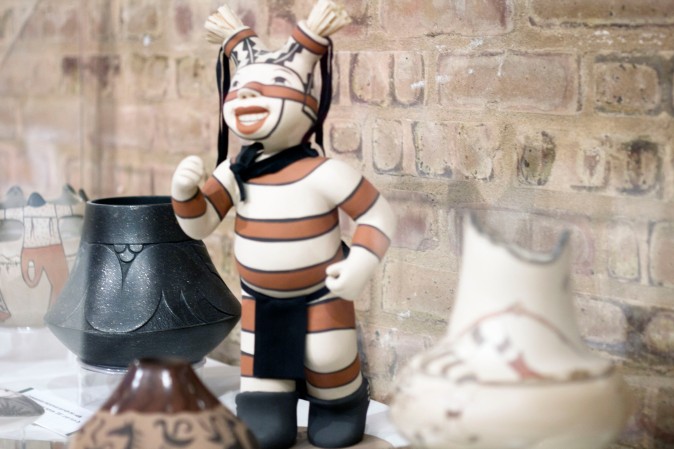Exhibits curator Janelle Stanley weaves Native art history into the public domain
When she was nine-years-old, Janelle Stanley sat wide-eyed, watching intently as her grandmother worked away at her loom.
Every spring, five or six families in the Diné community would gather with the elders to shear the sheep to take home their share of wool. The wool was sorted, cleaned and placed on sheets to be distributed amongst them. Stanley always admired the abilities of the women to negotiate with each other without being confrontational. The oldest woman, who was the most respected weaver, always got the first pick of the lot.
“My grandmother was definitely a big influence on that tactile aspect of art,” says Stanley. “We do believe that when you are thinking and making something that whatever your thoughts are, you can trap it or you can put it into the art itself.”
Now 50-years-old, Stanley’s drive to promote spoken history through art engulfs almost every aspect of her life.
Guests entering the Mitchell Museum of the American Indian’s brick red door in Evanston, Ill. are greeted by Stanley’s current curatorial work. With a year as the museum’s exhibits curator under her belt, she explains each part of her miniature artwork and pottery presentations— dense display boxes with donated artifacts and accompanying research.

Stanley at the Mitchell Museum of the American Indian; photo by Bianca Smith
“Older white American adults still reference Native Americans in a stereotypical way…there’s still such a heavy stereotype of Native Americans out here,” Stanley says. “It’s not just here— it’s even in the Southwest where there is larger known Native American population. But throughout the Midwest area, that’s something that I have experienced. People still presume that all Native Americans speak the same language, that we still all live in teepees, and we all wear headdresses.”
Stanley stresses that she is not trying to preach. She wants to share information, promising that museum attendees don’t have to digest her perspective; they just have to listen.
“We have our own food, we have our own language, we have our own types of designs, our own sense of who we are,” Stanley says.
Shortly after graduating from Arizona State University in 2007 with a BFA in fibers, Stanley utilized traditional weaving and basketry design elements to create two walkways at the Sky Harbor Airport in Phoenix. The projects, sponsored by the Phoenix Office of Arts and Culture, were created out of terrazzo that spanned both a football field’s length for one project and half of a basketball court for the other. Both were completed within six months of each other, but planning and execution took roughly seven years overall.

“Koshares” by Kathleen Wall, a piece from the Mitchell Museum’s “Pottery: A Timeless Tradition” exhibit; photo by Bianca Smith
“Another Native friend of mine that said something of the sort that I’m the second Native female that has public art [in Arizona],” Stanley says, hiding a grin. “I will continue to submit proposals nationwide and it’s given me the confidence. I know how to do this now, after all those years I’ve learned the process a lot better just being up and close to it.”
During her time spent as an intern at the Heard Museum in Phoenix, she completed extensive biographical research on Hosteen Klah, a medicine man and healer whose ceremonial sand paintings were rendered into large woven textiles in the early 1900s.
“There’s no word for art in indigenous culture because the things that we have, we appreciate it,” Stanley says. “We don’t necessarily call it art, because there’s more than that that goes into it.”
Her time spent as a volunteer in the Anthropology Department at Field Museum in Chicago surpassed just classifying artifacts. Researching different Midwestern tribes’ dwellings before and after European contact informed the creation of an interactive booklet for school-age children, who could find the dwellings at the museum and easily understand some key information about those Native structures was the end goal of her time spent there.

Stanley explains art exhibits to visitors at the Mitchell Museum; photo by Bianca Smith
“There is no recognized Native land in the state of Illinois,” Stanley says. “What would be fantastic here would be to acknowledge that there were and there are still descendants of tribes that were once abundant here in the state…And the just letting people know— what is native culture? Putting that question out there and then from there stepping into [the] food, language, dwellings, [and] clothing.”
Involving all communities to gain an unfiltered education on American Indians— children included—hits home for Stanley, a mother of two, who is trying to navigate how to keep her culture alive in settings where traditions seem to be stifled.
“My daughters—they’re half-Native,” Stanley says. “I tell them you have to make that extra effort to try to learn your language, try to learn a particular ceremony or become aware of it. For us that have moved into an urban setting, it takes work to do it.”
“Not too long ago, we had a family gathering and there was an elder who said we need to write our own stories. We’ve had other people write our stories. We need to tell our experience, our knowledge [and] our voices.”
Now back in Arizona with her family for the foreseeable future, Stanley will continue to create public art. She also plans on communicating with the native community and “letting them know that there are opportunities to pursue their art.”
Written by Bianca Smith
Edited by Jaclyn Jermyn